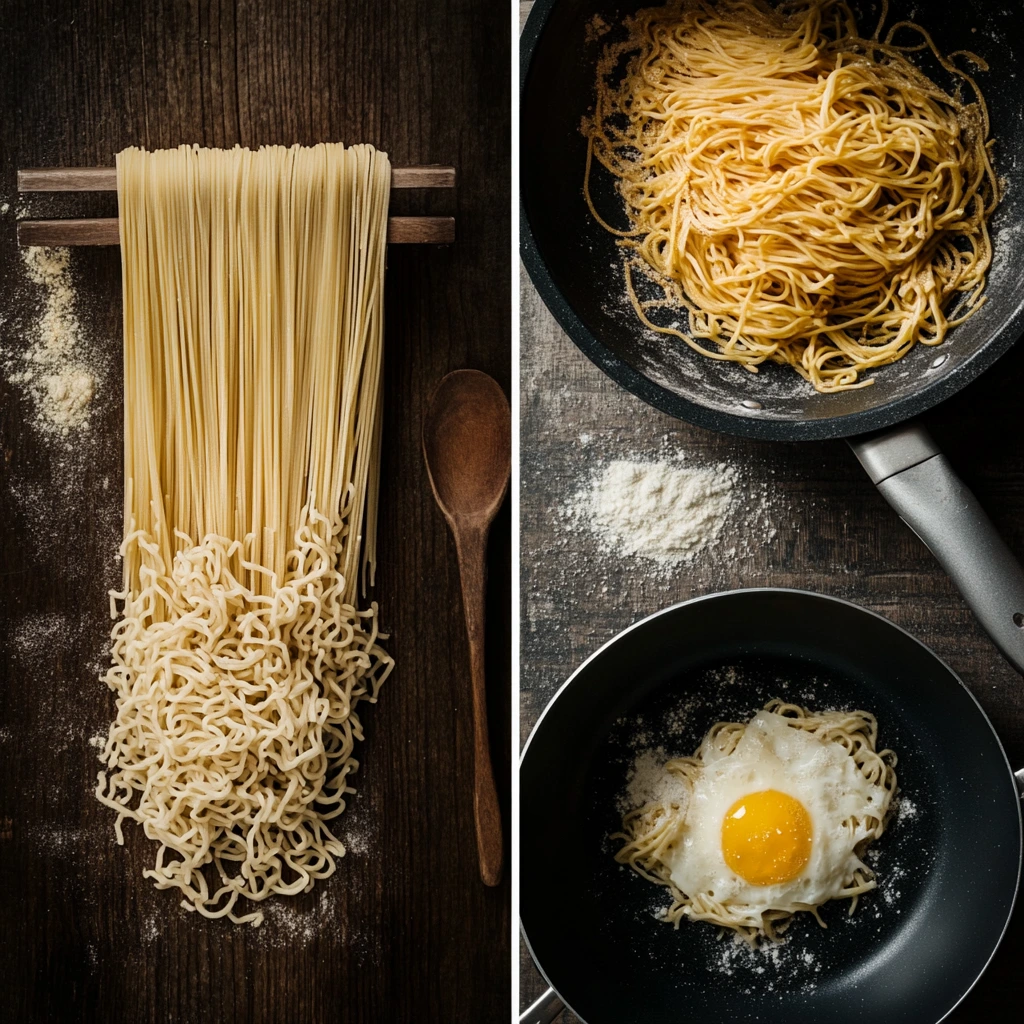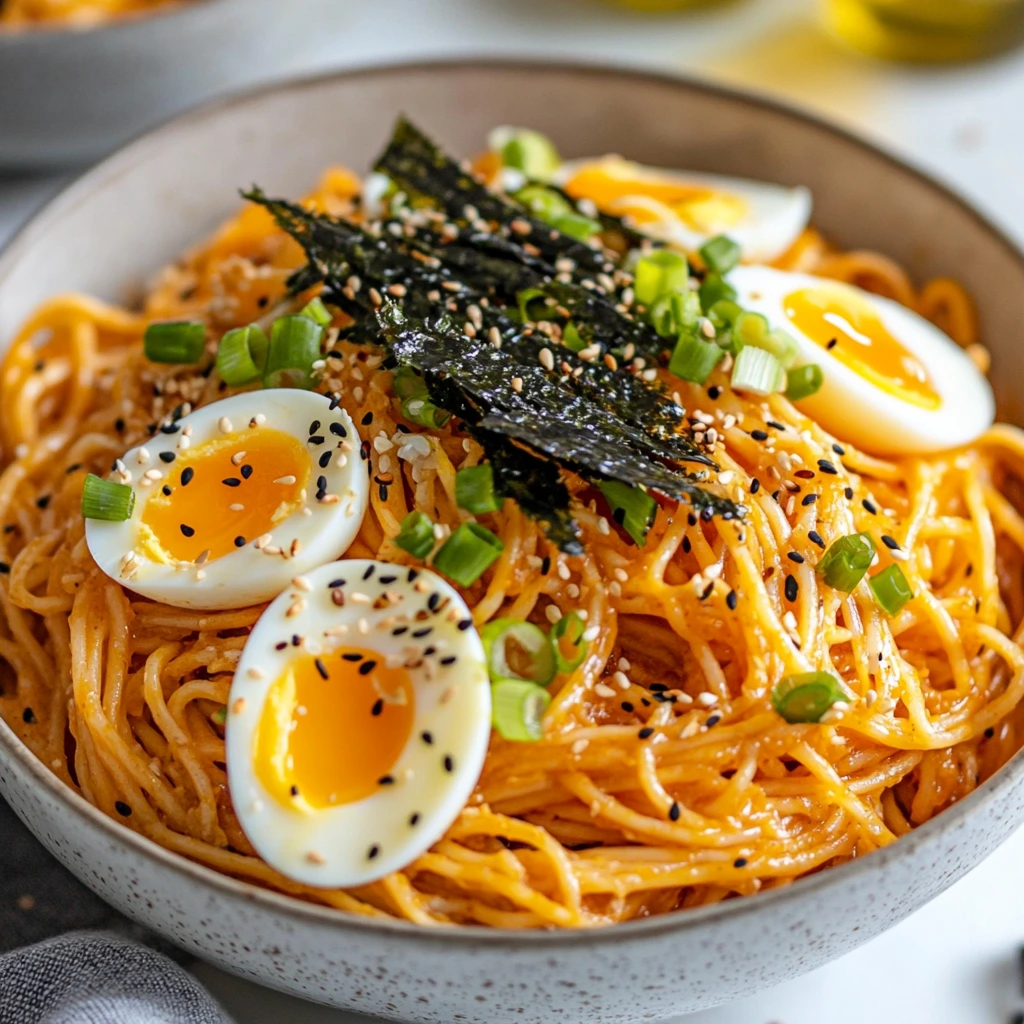Ramen is a globally beloved dish, celebrated for its flavorful broths, diverse toppings, and signature noodles. But what happens when traditional ramen noodles aren’t available? Many turn to pasta as a convenient and creative substitute. This article explores what pasta is best for ramen?, offering insights into how different pasta types can mimic the texture, flavor, and overall experience of authentic ramen noodles. Whether you’re experimenting in the kitchen or simply looking for accessible alternatives, understanding these substitutions can transform your ramen dishes.
However, traditional ramen noodles may not always be accessible. This has led to the growing trend of using pasta as a substitute. Pasta’s versatility and availability make it an appealing option for ramen enthusiasts seeking convenience or exploring fusion cuisine. By selecting and preparing pasta thoughtfully, home cooks can recreate the ramen experience without compromising on flavor or texture.
Table of Contents
1. Characteristics of Traditional Ramen Noodles
Ramen noodles are unique, crafted with wheat flour, water, and kansui, an alkaline water that gives the noodles their distinct chewiness and slight yellow hue. Kansui’s alkalinity strengthens the noodle structure, ensuring they remain firm even after soaking in hot broth. The noodles range from thin and curly to thick and straight, tailored to different types of ramen, from the light shoyu to the rich tonkotsu.
Their texture is a key feature, offering a springy bite that contrasts beautifully with the broth’s silky smoothness. Ramen noodles are designed to absorb flavors while retaining their integrity, making them a perfect vehicle for the dish’s complex taste profile.
For those substituting pasta, understanding these characteristics—alkalinity, chewiness, and flavor absorption—is crucial to replicating the ramen experience.
2. Reasons for Using Pasta as a Ramen Substitute
Pasta has become a go-to substitute for ramen noodles due to its accessibility, convenience, and culinary adaptability. While ramen noodles might require a trip to a specialty store, pasta is widely available and inexpensive. For those with dietary preferences, pasta offers gluten-free and whole-grain options, catering to diverse needs.
Pasta’s ability to take on various flavors also makes it ideal for fusion cuisine. By tweaking preparation techniques, pasta can mimic the texture and taste of ramen noodles, allowing for experimentation without straying far from tradition. Whether for a quick weeknight dinner or an adventurous culinary experiment, pasta provides an excellent base for ramen-inspired dishes.
3. What Pasta is Best for Ramen? Criteria for Selecting Pasta as a Ramen Substitute
Not all pasta works well as a ramen substitute. The best choices mimic the texture, thickness, and flavor absorption of ramen noodles. Here are some key criteria to consider:

- Texture: The pasta should have a firm bite similar to ramen’s chewiness. Look for options like spaghetti or linguine, which can replicate this quality with proper preparation.
- Flavor Absorption: Pasta that absorbs broth flavors effectively enhances the dish. Thin noodles like angel hair excel in lighter broths, while thicker options like fettuccine pair well with richer broths.
- Cooking Time: The cooking time of pasta should align with ramen noodle preparation, ensuring consistency in the final dish. Slight undercooking (al dente) can help achieve the desired texture.
- Shape and Size: The shape of the pasta should match the style of the ramen dish. Thinner pasta suits shoyu or shio ramen, while broader pasta works well with hearty tonkotsu or miso broths.
By considering these factors, home cooks can elevate their pasta-based ramen creations, achieving both authenticity and innovation.
4. Top Pasta Choices: What Pasta is Best for Ramen?
The following pasta varieties work best for ramen-style dishes, each bringing unique qualities to the table:

- Spaghetti: Its thickness and shape closely resemble some ramen noodles. With alkaline treatment (boiling with baking soda), spaghetti can achieve a springy texture, making it ideal for shoyu or shio ramen.
- Angel Hair Pasta: Its delicate texture and quick cooking time make it a suitable choice for light and clear broths. Pair it with shio or vegetarian ramen for a refined touch.
- Linguine: The flat, slightly wider shape of linguine pairs well with creamy miso or shoyu broths. It offers a satisfying chew that holds up to hearty toppings.
- Fettuccine: With its broad, thick profile, fettuccine is perfect for rich tonkotsu broths. Its substantial nature balances the creaminess and depth of pork-based ramen.
By selecting the right pasta and adapting its preparation, these options can seamlessly replace traditional ramen noodles in a variety of dishes.
5. Preparation Techniques to Enhance Pasta for Ramen
Here’s a table summarizing the preparation techniques to enhance pasta for ramen:
| Technique | Description | Key Benefits | Pro Tips |
|---|---|---|---|
| Alkaline Treatment | Boil pasta in water with 1–2 tbsp baking soda per liter. | Mimics kansui, creating a chewy texture and slight yellow hue. | Expect a soapy smell during boiling; rinse pasta after to remove excess baking soda. |
| Cooking Pasta Al Dente | Cook pasta 1–2 minutes less than package instructions. | Achieves firm, springy texture similar to ramen noodles. | Avoid overcooking; mushy pasta absorbs too much broth and loses texture. |
| Rinsing the Pasta | Rinse cooked pasta under cold water to remove excess starch. | Prevents clumping, firms texture, and enhances broth absorption. | Use running water to cool pasta quickly and ensure chewiness. |
| Letting the Pasta Rest | Allow rinsed pasta to rest for a few minutes before adding to the broth. | Stabilizes texture and makes it firmer, more like ramen noodles. | Slight drying improves noodle integrity and makes them more broth-friendly. |
| Infusing Flavor | Add salt, soy sauce, or miso paste to boiling water or toss cooked pasta with sesame oil or broth. | Enhances pasta’s flavor, making it closer to ramen noodles. | Use light seasoning to avoid overpowering the broth’s natural flavor. |
| Broth-Ready Adjustments | Match pasta preparation to the broth type (e.g., undercook for richer broths). | Ensures the pasta absorbs broth flavors and complements the soup’s richness. | For heavy broths, let pasta finish cooking in the broth to integrate flavors. |
| Handling Thick Pasta | Use thicker pasta (e.g., linguine, fettuccine) for heartier ramen styles and cut it into shorter pieces. | Ensures easier handling and more uniform bites in the dish. | Pair thicker noodles with robust broths like tonkotsu or miso for a balanced dish. |
| Enhancing Visual Appeal | Toss pasta lightly in broth or sesame oil before plating and arrange in a swirl in the bowl. | Creates an attractive presentation while adding a light sheen to the noodles. | Ensure pasta is well-drained before tossing to prevent a watery appearance. |
6. Pairing Pasta Types with Ramen Broths
Pairing the right pasta with ramen broth is crucial to harmonizing flavors and textures:
- Spaghetti with Shoyu Broth: The medium thickness of spaghetti mirrors the texture of shoyu ramen noodles. Its neutral flavor absorbs the soy-based broth, creating a balanced, savory dish.
- Linguine with Miso Broth: The rich, slightly creamy miso broth pairs beautifully with linguine. The flat noodles complement the bold umami flavors, especially when garnished with green onions, corn, and sesame seeds.
- Fettuccine with Tonkotsu Broth: Thick fettuccine is ideal for the creamy, pork-based tonkotsu broth. The broad noodles hold up well under the weight of hearty toppings like chashu (braised pork) and boiled eggs.
Experimenting with these combinations allows home cooks to tailor their ramen creations to their preferences.
7. Flavor Enhancement Techniques
Enhancing the flavor of pasta-based ramen involves thoughtful preparation and seasoning:
- Seasoning the Pasta: Add salt or a small amount of soy sauce to the boiling water for subtle flavor infusion.
- Broth Preparation: Adjust the broth’s seasoning to complement the pasta. Rich broths may require a touch of acidity, such as rice vinegar, to balance the flavors.
- Toppings Selection: Choose toppings that harmonize with both the broth and pasta. Common options include soft-boiled eggs, nori (seaweed), bamboo shoots, and sautéed mushrooms.
These techniques ensure the final dish delivers a cohesive and satisfying flavor profile.
8. Common Mistakes to Avoid When Using Pasta in Ramen
Substituting pasta for ramen noodles can be tricky if certain details are overlooked. Here are the most common mistakes and how to avoid them:
- Overcooking the Pasta
Overcooked pasta becomes mushy and lacks the firm texture of ramen noodles. To avoid this, cook pasta al dente (slightly undercooked) and rinse it in cold water immediately after boiling to stop further cooking. - Skipping Alkaline Treatment
Without boiling pasta in water with baking soda, it won’t replicate ramen’s chewy texture. Add one tablespoon of baking soda per liter of water to mimic the alkalinity of kansui. - Mismatched Pasta and Broth
Using pasta shapes that don’t suit the broth can throw off the balance. For example, delicate angel hair doesn’t pair well with rich tonkotsu broth. Match thin pasta with light broths and thicker noodles with hearty ones. - Not Rinsing the Pasta
Failing to rinse boiled pasta leaves excess starch, preventing it from properly absorbing broth flavors. A quick rinse also firms up the texture. - Underseasoning Pasta
Unlike ramen noodles, pasta needs extra seasoning during cooking. Add salt or a touch of soy sauce to the boiling water for better flavor integration.
By avoiding these mistakes and following simple adjustments, your pasta-based ramen can deliver a satisfying, noodle-like experience.
9. Health Considerations
When substituting pasta for traditional ramen noodles, it’s important to consider the nutritional differences and how they align with dietary needs. Here’s a closer look at the health aspects of using pasta in ramen dishes:
- Nutritional Differences Between Pasta and Ramen Noodles
Traditional ramen noodles, made with kansui, are high in carbohydrates but generally low in fiber and protein. Pasta, depending on the variety, can provide a more balanced nutritional profile. For example:- Whole-grain pasta: Contains more fiber, which promotes digestion and helps with blood sugar control.
- Protein-enriched pasta: Adds an extra boost of protein, making it a better choice for those looking to increase their protein intake. However, pasta may lack the unique minerals or trace nutrients found in kansui-treated ramen noodles.
- Lower Sodium Levels
Ramen noodles are often high in sodium due to their manufacturing process and seasoning packets. Using plain pasta allows you to control the sodium levels in your dish, especially if you’re mindful of the broth’s salt content. - Gluten-Free Options for Dietary Restrictions
For those with gluten intolerance or celiac disease, pasta offers a wide range of gluten-free alternatives made from rice, quinoa, or legumes. These can be paired with compatible broths and toppings to create a satisfying, gluten-free ramen dish. - Calorie Control and Weight Management
Pasta’s calorie content varies depending on the type, but choosing options like whole-grain or lentil-based pasta can provide more satiety with fewer empty calories. This makes pasta a viable option for those managing calorie intake while still enjoying a ramen-inspired meal. - Customizing for Healthier Ramen Dishes
Using pasta as a ramen substitute allows for healthier customization. Incorporating lean protein (like grilled chicken or tofu) and a variety of vegetables (like spinach, mushrooms, and carrots) can enhance the nutritional value of the dish. Additionally, reducing oil or cream in broths can make the meal lighter without sacrificing flavor.
By considering these health factors, substituting pasta for ramen can cater to specific dietary goals while retaining the essence of a hearty and satisfying meal.
10. Cultural Perspectives on Fusion Cuisine
Using pasta in ramen exemplifies the evolving nature of cuisine. Japanese cooking embraces innovation, blending traditional techniques with global influences. Fusion dishes like pasta-based ramen reflect the adaptability of food cultures in a globalized world.
This approach highlights culinary creativity while honoring the essence of ramen. As fusion cuisine grows, it fosters appreciation for diverse flavors and traditions, enriching the global food landscape.
11. Frequently Asked Questions (FAQs)
Can I use any pasta for ramen?
While you can experiment with different types of pasta, certain shapes like spaghetti or linguine work better for ramen due to their texture. For inspiration on how to creatively use pasta in unique ways, check out this guide on How to Make Perfect Ramen Lasagna. It showcases innovative uses of noodles that might inspire your ramen-making adventures.
How do I make pasta taste more like ramen noodles?
To make pasta mimic ramen noodles, boil it in water with baking soda to achieve the characteristic chewiness and flavor. This technique is similar to innovations like Ramen Lasagna with Ground Beef, where the use of noodles is creatively adapted.
What is kansui, and why is it important?
Kansui is an alkaline solution essential for ramen noodles’ unique texture and color. If you’re interested in learning how different noodle treatments can influence recipes, explore How to Make Perfect Ramen Lasagna to see how texture impacts dish preparation.
Are there health benefits to using pasta instead of ramen noodles?
Yes, using pasta can offer more dietary flexibility, including lower sodium and higher fiber options. For ideas on how to create balanced meals, you might enjoy Why Ramen Lasagna with Ground Beef Is Your New Favorite Meal, which discusses innovative and nutrient-rich noodle recipes.
How can I make gluten-free ramen at home?
Gluten-free pasta, such as rice or chickpea-based options, works well for ramen substitutes. Consider pairing these noodles with broths inspired by creative recipes like Ramen Lasagna with Ground Beef to ensure a flavorful and satisfying meal.
Conclusion
Experimenting with pasta as a ramen substitute opens new possibilities for creativity and convenience in the kitchen. By understanding the characteristics of ramen noodles and applying thoughtful preparation techniques, pasta can successfully mimic traditional textures and flavors. Whether you’re embracing fusion cuisine or adapting to dietary needs, pasta-based ramen offers a delightful twist on a beloved classic. Let your culinary imagination run wild and enjoy the endless potential of ramen-inspired dishes!

